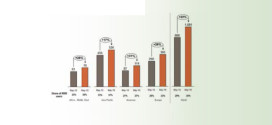The launch and listing of the first Exchange Traded Fund (ETF) in the Gulf region took place in March thanks to the National Bank of Abu Dhabi (NBAD ) and Abu Dhabi Securities Exchange (ADX).
The new fund, NBAD OneShare Dow Jones UAE 25 ETF, will follow the performance of the “Dow Jones UAE 25 Total Return Index” and provide investors with exposure to 25 blue-chip companies from across the UAE .
Tom Healy, AD X’s chief executive, welcomed this major milestone in the regional capital markets. He said that since the introduction of the first ETF in the United States in 1993, ETFs have opened a whole new landscape of investment opportunities for both institutional
and private investors, both local and foreign.
He added that the main advantages of ETFs were that investors could achieve diversified portfolios with lower transaction costs than purchasing the relevant range of underlying shares; and that ETFs had significantly lower expense ratios than other funds. Rashed Al-Baloushi, deputy chief executive of AD X, announced that AD X started working on the ETF in 2008 in an attempt to provide investors with a new product
that would enable them to have exposure to an index to diversify investment risks at relatively low cost. ETFs would contribute to encouraging retail investors to better manage their risk exposure while investing in the stock market.
Alan Durrant, chief investment officer of NBAD ’s Asset Management Group, said that the NBAD OneShare Dow Jones UAE 25 ETF would give investors the opportunity to gain real-time, cost-effective exposure to a broad basket of UAE shares. It had the diversification benefits of a mutual fund and the instant liquidity of a share.
He added that ETFs were fast becoming the product of choice for international investors and “we see the NBAD OneShare Dow Jones UAE 25 ETF as being an ideal way for global investors to access the exciting opportunities available in our local companies”.
 Cash And Trade Magazine For Cash and Trade professionals in the Middle East
Cash And Trade Magazine For Cash and Trade professionals in the Middle East




